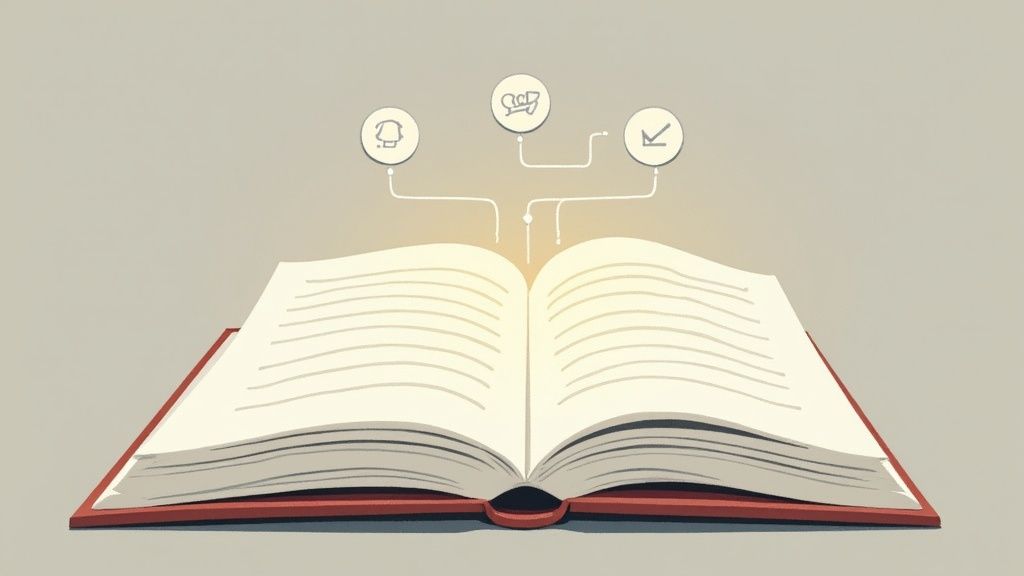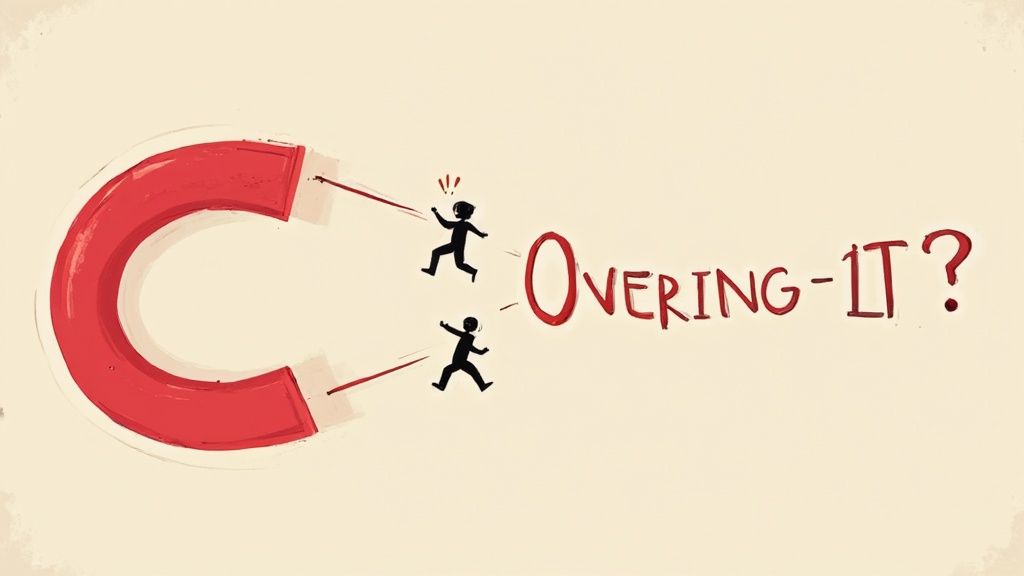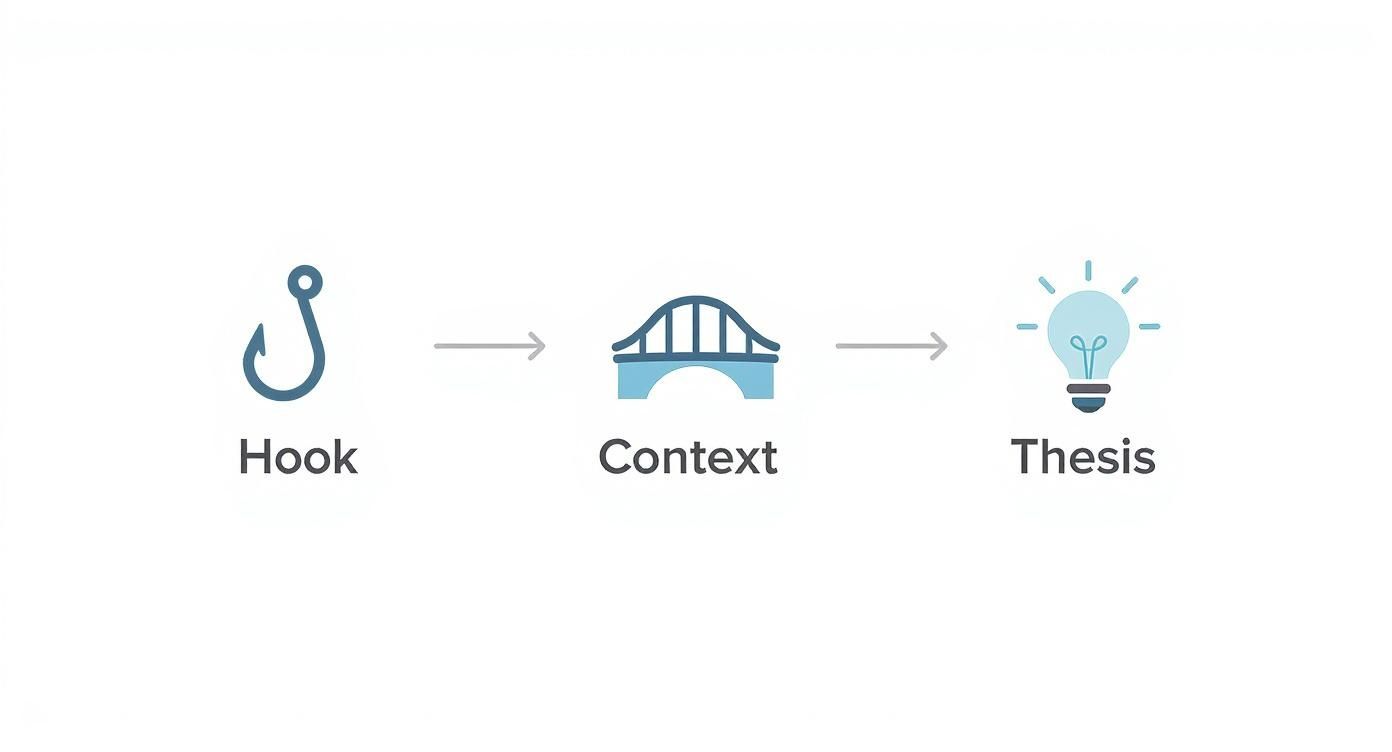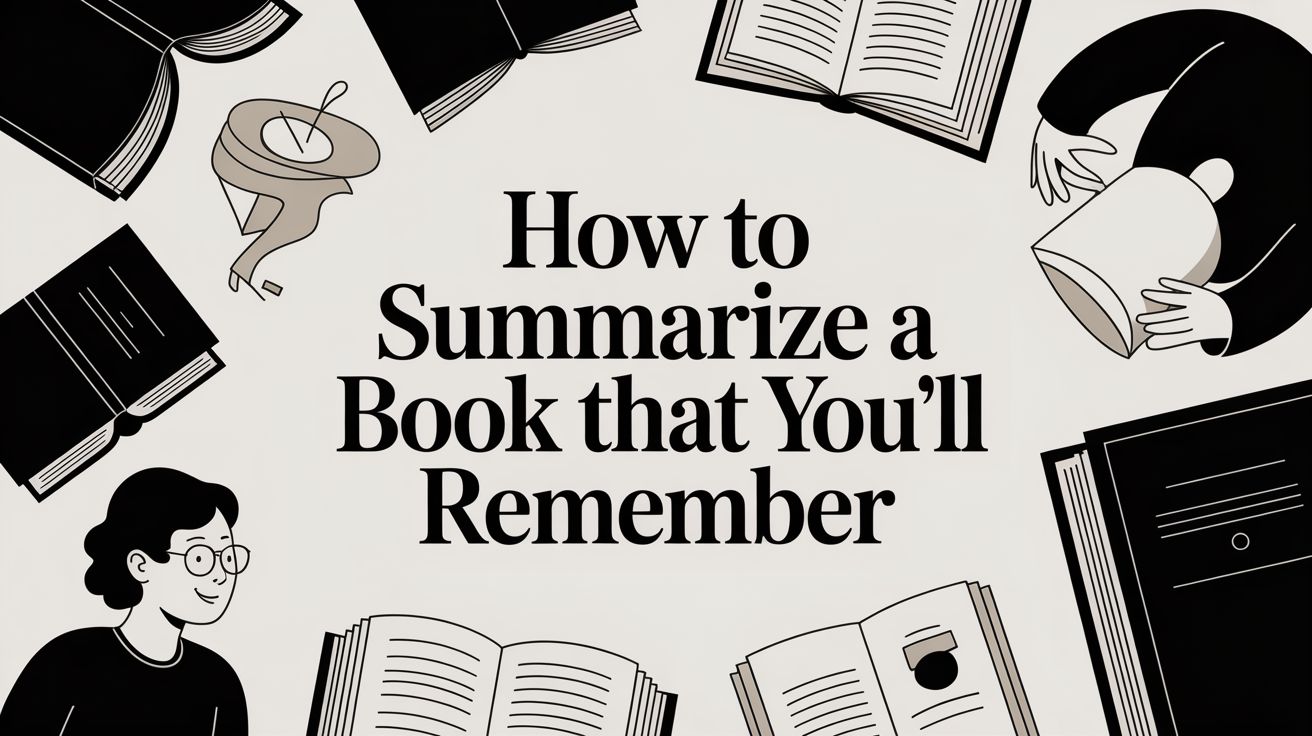How to write a good essay introduction: Hook readers fast
How to write a good essay introduction: learn proven techniques to hook readers, set context, and craft a strong thesis

A great essay introduction really only has three jobs to do: it needs to hook the reader, provide just enough context, and lay out a clear, arguable thesis statement. Getting this combination right isn't about following a rigid formula; it's your first—and best—opportunity to show your reader that your ideas are worth their time.
Why Your Essay Introduction Matters Most

Think of your introduction as the front door to your argument. If it’s messy, confusing, or just plain boring, your reader is likely to turn around and walk away. That first impression really is everything. A powerful opening paragraph sets the tone for your entire paper, establishing your credibility and signaling why your topic is important right from the get-go.
This isn't just a hunch; it's rooted in how we all process information. Studies in education have shown that readers often decide within the first 30 seconds if something is worth reading carefully. A well-crafted introduction that piques their curiosity from the start is absolutely essential for keeping them on the page.
It's no surprise, then, that over 70% of colleges across the U.S. and Europe explicitly require a clear thesis and proper context in introductory paragraphs. Digging into various essay writing strategies reveals just how fundamental this structure is.
The Three Core Jobs of an Introduction
To pull off a truly effective introduction, you have to make sure it's doing its three main jobs. Each piece logically flows into the next, building a smooth on-ramp for your reader.
Here's a quick breakdown of what your introduction needs to accomplish.
The Three Jobs of an Effective Introduction
| Component | Purpose | What to Include |
|---|---|---|
| The Hook | Grab the reader's attention immediately. | A surprising fact, a provocative question, a relevant quote, or a short, compelling story. |
| The Context | Orient the reader. | 2-3 sentences of background information needed to understand your topic and why it's relevant. |
| The Thesis Statement | State your main argument or purpose. | A single, clear, and debatable sentence that outlines the main point you will prove in the essay. |
Let's look at each of these components a bit more closely.
The Hook: This is your opening. It's the first line or two designed purely to spark interest. Its only goal is to make someone think, "Okay, I'm listening."
The Context: Once you have their attention, you need to build a small bridge. These sentences give your reader the essential background they need to understand where you're coming from. It’s not the whole story, just enough to get them grounded.
The Thesis Statement: This is the core of your introduction and the engine for the entire essay. It’s a specific, debatable sentence that clearly states the argument you're about to prove.
Key Takeaway: A successful introduction isn't a summary of your essay; it's a roadmap. It tells the reader where you're going (the thesis), why the trip is worthwhile (the hook), and what they need to know to follow the directions (the context).
If you skip any of these elements, you're building your argument on shaky ground. Without a hook, your essay starts with a whimper. Without context, your thesis will feel like it came out of nowhere. And without a solid thesis, your reader will be left wondering what the point of it all is.
Mastering the Art of the Hook

Think of your opening sentence as the most critical part of your entire introduction. It's your handshake, your first impression. It's the one chance you get to stop a reader from scrolling and convince them your essay is worth their time. A great hook makes them lean in, ask a question, and feel an immediate need to find out what you have to say.
This isn’t about cheap gimmicks. It’s about creating genuine curiosity. The best hooks feel like the start of a compelling story or the reveal of a surprising secret. They work because they tap into our natural desire for answers.
One of the most common mistakes that can sink a perfectly good essay is a weak opening. A flat start like, "Social media has become very popular in recent years," tells the reader something they already know. It signals a generic, uninspired argument is on the way. We want to avoid that predictable path and instead open with something that creates an instant connection.
Choosing the Right Type of Hook
The perfect hook depends entirely on your essay's topic and tone. A somber historical analysis calls for a different opener than a lighthearted personal narrative. The trick is to match the hook's style to your subject matter and the argument you're about to make.
Here are a few proven techniques you can adapt:
The Surprising Statistic: Starting with a shocking number immediately establishes your authority and shows why your topic matters.
- Example for an essay on food waste: "Every year, American consumers throw away nearly 40 million tons of food, an amount equivalent to wasting every single bite of food for over four months."
The Provocative Question: Asking a thoughtful question forces the reader to pause and reflect. It gets them mentally engaged with your topic before you’ve even stated your thesis.
- Example for an essay on artificial intelligence: "If an AI can create a masterpiece painting, does that redefine what it means to be an artist, or what it means to be human?"
The Vivid Anecdote: A short, personal story can create an instant emotional connection, making an abstract topic feel real and relatable.
- Example for a narrative essay: "The first time I saw the northern lights, the sky didn't just light up—it felt like the entire universe was breathing in silent, electric waves of green and purple."
A Writer's Insight: The best hook is often the one you discover after you've written a full draft. Once you truly understand your argument, you can go back and craft an opening that perfectly sets the stage for your most powerful points.
Matching Your Hook to Your Essay Type
Your essay’s purpose should dictate the kind of opening you choose. You wouldn't start a scientific paper with a deeply personal story, just as you wouldn't open a narrative with a dry statistic.
Here’s a quick guide to aligning your hook with different essay styles:
Argumentative/Persuasive Essay: Your goal is to convince. Lead with a surprising fact, a bold claim, or a common misconception. This immediately frames the debate and positions your argument as a necessary intervention.
Expository/Analytical Essay: Your goal is to explain or analyze. Try using a relevant quote from a key text, a historical parallel, or a concise definition of a complex term. This sets a more scholarly, informative tone from the get-go.
Narrative Essay: Your goal is to tell a story. You need to drop the reader right into the action. Begin with vivid imagery, a piece of dialogue, or an action that makes them feel like they're in a specific moment.
Finding the right hook is more of an art than a science. My advice? Experiment with a few different openings and read them aloud. The one that makes you want to keep reading is probably the one that will capture your audience, too.
Building the Bridge from Hook to Thesis
Alright, you’ve landed a killer hook. You’ve got their attention. But that attention is fleeting, and now you have to do the real work: connecting that initial flash of interest to the heart of your essay—your thesis. This is where you build the bridge.
Think of these next few sentences as setting the stage. If you just drop your thesis statement in right after a surprising fact or a poignant question, it can feel jarring and out of place. It’s like a punchline without the setup. You need to give the reader just enough background to understand why your argument matters and where it’s coming from. This isn’t the time for a deep dive; it’s a quick, focused orientation.
Getting this transition right is tough for almost everyone. In fact, within the essay writing service industry, a staggering 60% of clients specifically ask for help with their introductions and thesis statements. It's a common struggle, especially for students who are trying to frame a topic for an audience that might not share their cultural or academic background. If you're curious about these trends, you can dig into the full market research on essay writing services.
Setting the Scene Without Overwhelming
The key to providing context is finding that perfect balance. Too little information, and your thesis seems to appear out of nowhere. Too much, and you’ve basically written your first body paragraph in the introduction, burying your reader in details before they even know what you're arguing.
Every single word in this section needs to serve a purpose: preparing the reader for your thesis.
Here’s how you can do it effectively:
- Define a Key Term: If your whole essay revolves around a slippery concept like "neoliberalism" or "authenticity," spend a sentence clarifying how you will be using that term. This sets clear boundaries for your argument.
- Provide Brief Historical Context: Writing about the impact of social media on politics? A quick sentence reminding the reader of the pre-internet political landscape can work wonders. You just need a snapshot, not a history lesson.
- Outline the Scope: Your topic might be huge—like the global supply chain—but your essay isn't. Use a sentence to narrow the reader's focus to your specific angle, like its impact on small businesses in the Midwest.
Pro Tip: Imagine your context sentences as a funnel. Start with a slightly broader idea that links back to your hook, and then get more specific with each sentence. This creates a natural, logical flow that leads the reader right to your thesis.
Nailing this part of the intro quickly is a game-changer when you're short on time. For more tips on speeding up the entire process, check out our guide on how to write an essay fast.
Crafting a Powerful Thesis Statement
You’ve hooked your reader and set the scene. Now comes the most critical sentence in your entire essay: the thesis statement. Think of it as the engine of your paper—it’s not just a topic summary, but the specific, debatable claim you’re going to spend the whole essay proving.
A lot of writers stumble here by mistaking a simple fact for a thesis. For example, "Climate change is a global issue" is true, but it's a dead end. It doesn’t present an argument or leave any room for discussion. A real thesis is a claim someone could reasonably disagree with, and that's what gives your essay a purpose.
Your mission is to put forward a focused, arguable point of view that directly answers the core question of your essay prompt.
This infographic breaks down how your hook, context, and thesis should work together, creating a seamless and powerful introduction.

As you can see, each piece logically flows into the next. The thesis isn't just tacked on at the end; it's the destination the rest of your intro has been building toward.
From Vague Idea to Sharp Thesis
So, how do you get from a broad topic to a razor-sharp thesis? It all starts by asking the right kind of question.
Let's say your general topic is "technology in education." That's too big. To narrow it down, ask a specific "how" or "why" question. For instance, "How has the integration of tablets into elementary school classrooms affected literacy skills?"
Your first stab at an answer might be something like, "Tablets in classrooms have changed how kids learn to read." It’s a start, but it’s not quite a thesis yet. It's too vague and doesn't take a clear stance. You need to make a specific, debatable claim.
A great thesis doesn't just announce your topic; it delivers your verdict on it. It tells the reader exactly what you believe and hints at how you're going to prove it.
Polishing Your Thesis for Maximum Impact
Once you have a core argument, it’s time to refine the wording. A powerful thesis is both specific and confident. Let’s polish our earlier example.
- The Vague Start: "Tablets in classrooms have changed how kids learn to read."
- The Stronger Thesis: "While tablets offer engaging learning tools, their overuse in elementary classrooms has hindered the development of deep reading comprehension skills by prioritizing interactive distractions over sustained focus."
See the difference? The second version is much more effective. It’s:
- Arguable: Someone could easily argue that tablets actually improve comprehension.
- Specific: It zeroes in on "deep reading comprehension" and "interactive distractions."
- A Roadmap: It previews the essay's structure. You know the paper will explore the pros and cons before landing on its conclusion.
Watching a weak thesis evolve into a strong one is the best way to learn. Here are a few examples across different essay types.
Transforming Weak Thesis Statements into Strong Ones
The table below shows how a generic, forgettable thesis can be transformed into a specific, compelling argument that sets the stage for a great essay.
| Essay Type | Weak Thesis Example | Strong Thesis Example |
|---|---|---|
| Argumentative | Smoking is bad for your health. | The implementation of nationwide public smoking bans is the most effective policy for reducing long-term healthcare costs associated with tobacco use. |
| Expository | Shakespeare’s Hamlet is a play about revenge. | Shakespeare's Hamlet explores the theme of revenge not as a simple quest for justice, but as a corrosive force that destroys the protagonist’s morality and sanity. |
| Narrative | My trip to the mountains was a great experience. | My solo backpacking trip through the Sierra Nevada taught me that true self-reliance isn't about physical strength, but about mental resilience in the face of unexpected failure. |
In every strong example, the statement makes a specific, debatable claim. It gives the writer a clear direction and tells the reader exactly what to expect. That's the hallmark of a thesis that truly works.
Common Introduction Mistakes to Avoid
Writing a great introduction can feel like walking a tightrope. Even if you have a killer hook and a solid thesis, a few common stumbles can send your whole opening paragraph tumbling. The good news is that once you know what these traps look like, they’re surprisingly easy to sidestep.
One of the biggest culprits is the overly broad, cliché opener. We’ve all seen them: "Since the dawn of time, humanity has..." or "Throughout history, great leaders have..." These statements sound grand, but they're so vague they say absolutely nothing. Your reader is looking for a specific, compelling idea, and these empty phrases are a sign that a generic argument is about to follow.
Ditching Predictable Formulas
Another classic mistake is leading with a dictionary definition. Kicking things off with, "Webster's Dictionary defines 'courage' as..." is a surefire way to tell your reader you're out of original ideas. It's a tired crutch that doesn't offer any unique insight. Your job isn't to define a term; it's to explore its nuances and complexities within the context of your topic.
Just as robotic are the phrases that explicitly announce what you’re about to do. Sentences like, "In this essay, I will discuss..." or "This paper will explore the causes of..." strip all the confidence and style from your writing.
Key Takeaway: Let your thesis do the talking. A well-crafted introduction shows your reader the path you're taking without needing a signpost that says, "Here's what I'm about to do."
Check out the difference a small change can make.
- Weak Version: "In this essay, I will argue that Shakespeare's Hamlet uses the motif of madness to critique the political corruption of the Elizabethan court."
- Strong Version: "In Shakespeare's Hamlet, madness is not merely a reflection of personal turmoil but a powerful tool used to expose and critique the deep-seated political corruption of the Elizabethan court."
See how the second one just dives right in? It’s direct, academic, and far more engaging.
Refining Your First Draft
Spotting these issues in your own work is a critical editing skill. When you’re reviewing a draft, be ruthless. Every single sentence in your introduction needs to earn its place by grabbing the reader's attention and setting up your argument.
Here’s a quick mental checklist to run through when you’re editing your own intro:
- Is my hook generic? If you could slap it onto ten other essays, it needs to be more specific.
- Am I defining a basic term? Ditch the dictionary unless the word is incredibly technical or you’re challenging its traditional definition.
- Am I announcing my intentions? Hunt down phrases like "I will show..." and rewrite them to state your point directly.
Learning to write a strong introduction is as much about what you leave out as what you put in. By sidestepping these predictable traps, you let your own voice and argument take center stage, creating a powerful first impression that will carry your reader through the rest of the essay.
Got Questions About Introductions? We've Got Answers
Even when you know the basic formula for an introduction, a few nagging questions can pop up as you stare at that blinking cursor. Getting these details right is what separates a decent introduction from a great one. Let's tackle some of the most common uncertainties I see students struggle with.
How Long Should My Introduction Be?
This is probably the number one question I get. While there's no single magic number, a solid rule of thumb is to aim for about 8-10% of your total word count.
So, if you're writing a 1,000-word essay, that means your intro should land somewhere in the 80-100 word range. This keeps it concise and ensures you're setting the stage, not giving away the whole show before it even begins.
Is It Okay to Use "I" in My Intro?
Ah, the first-person dilemma. Whether you can say "I think" or "in my opinion" really boils down to the type of essay you're writing and what your instructor prefers.
- Formal Academic Papers (Argumentative, Expository): It's best to avoid it. Using "I" can sometimes make your argument sound like a personal opinion rather than a well-researched position. Sticking to the third person lends your writing more authority.
- Narrative or Reflective Essays: Go for it! These essays are all about your personal story and perspective. Using "I" is essential to making them feel authentic and engaging.
My Go-To Advice: When in doubt, leave it out. You can almost always make a sentence stronger by removing "I believe that..." and just stating your point directly. It’s more confident and gets straight to the point.
What if I Can't Think of a Good Hook?
Writer's block is a real beast, and it loves to show up right when you need a killer opening line. If you're completely stuck on the hook, here's the best trick in the book: don't write it first.
Seriously. Skip it. Write the rest of your essay—your body paragraphs, your conclusion, everything. Once you know exactly what your argument is and how it ends, it's so much easier to circle back and craft the perfect opener. You'll have a much clearer picture of the most surprising fact or compelling idea to lead with. This little hack takes off all the pressure and usually results in a much more powerful hook.
Still feeling stuck turning a prompt into a polished introduction? Feen AI can be a great brainstorming partner. It can help you generate ideas for hooks, tighten up your thesis statement, and map out your opening paragraph in seconds. You'll get clear, actionable suggestions to get your writing process moving. Give it a try at https://feen.ai.
Relevant articles
Discover the best good transition words for conclusions to elevate your essays. Our guide offers examples, tips, and templates to make your writing stand out.
Learn how to summarize a book with our guide for students. Master practical note-taking and writing techniques to capture the core ideas of any text.
How to write essay fast: Master quick research, outlining, and drafting to beat deadlines with a strong grade


